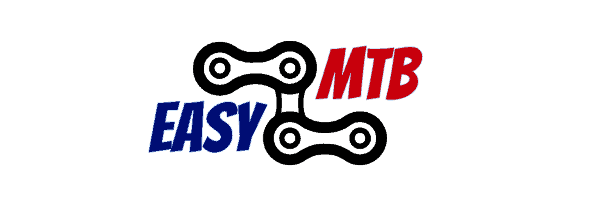Lush rolling hills, the Rocky Mountains, snow-covered peaks and valleys–these are just some of the terms that can be used to describe Colorado. When it comes to mountain biking, Colorado has more than enough varied terrain to offer an unforgettable MTB experience. No matter where in the state you choose to ride, there is literally something majestic and challenging for any MTB riding level. What makes Colorado so great for mountain biking?
Colorado is notorious for being one of the best locations on Earth for mountain biking. There are so many destinations throughout the state to choose from, that many riders have trouble deciding where exactly they wish to ride. The state is filled with perfect terrain for MTB.
In this guide, we are going to explore all the popular destinations for mountain biking in the state of Colorado. Colorado is filled with trails and parks that cater to every single level of MTB riding, therefore, there is a lot to cover and we leave no stone unturned. From downhill mountain biking to Hut to Hut, and everything in-between, Colorado is tied with California and the UK in terms of MTB popularity. Read on to find out why.
Downhill Mountain Biking in Colorado
Downhill mountain biking, in many ways, can also be referred to as the very first form of mountain biking, certainly MTB racing. Back in the early 1970s, the very first off-road bikes were first raced in Marin County, California. Although downhill racing has changed a lot over the years, the very first concept is still basically the same: top of the mountain to the bottom as fast as possible.
Extreme downhill mountain biking is often likened to downhill skiing in how the idea is the same, which is what makes downhill such an incredible style of MTB in Colorado. The riders smash open the start gate and then race down the terrain as fast as possible across rocky terrain that is almost unrideable if a fast speed is not used.
The only way to get faster with downhill Colorado MTB is to practice, and it must be said, to be willing to crash and burn. It is important to know why this is the norm for downhill racers when facing ski slopes.
It is because the rider that crosses the finish line in the fastest time is the winner. The tracks selected can be as long as 6 minutes with the 600-meter drop to the finish, and high-speed sections with large jumps that require tried and true experience and practice to execute perfectly. The only way to get faster to achieve a win is to throw caution to the wind while still maintaining what the normal safety threshold for downhill should be while on ski slopes.
Downhill races in Colorado typically take place in the summer, and riders are typically taken to the top of the terrain by a ski lift. Furthermore, downhill bikes have around 200 millimeters of suspension to soak up the punishing terrain, and large disc brakes will help disperse the heat that builds up, and the tires are built super tough with thick sidewalls and sticky rubber.
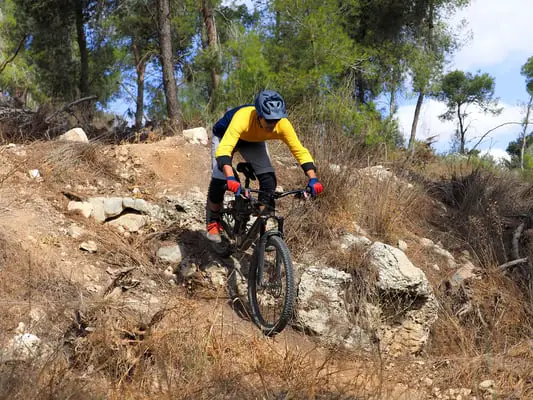
Wide and high handlebars along with a short stem will help get the weight behind the bike for downhill riding. So, to get faster, you need to ensure your bike meets the required parameters.
The pinnacle of downhill racing is the Trestle Gravity Series, which is a championship of six to eight events that take place in Trestle Bike Park. The rider with the most points at the end of the race is awarded the grand prize, therefore, only the fastest and best of the best can hope to compete.
Additionally, extreme downhill MTB in Colorado has a yearly one-off race known as the Fat Bike World Championship, and in this race, the top riders are all fiercely competitive, which makes this race an exciting spectacle, both for professional MTB riders competing and for spectators.
For both of these competitions, practice is absolutely crucial, as is the case with nearly all professional sports–MTB is no different, and riders need to put in countless hours of practice year-round in preparation for these races.
Although extreme downhill MTB racing in Colorado does come down to technical riding ability, the riders also need a superb level of fitness, particularly lower body fitness. Many of these top races can hit up to 2,000 watts of maximum power and regularly hit over 1,000 watts of power in just one run.
With a rider’s heart rate at near maximum capacity for the entire duration of the run, and coupled with the stamina needed to practice at maximum capacity for at least a few weeks before, downhill racers need to ensure that their bodies are 100% fit.
Downhill MTB in Colorado’s steep slopes is frightening at first, but you have to practice and accept the danger if you ever hope to get good at it.
In the winter, MTb riders flock to ski resorts to hit the slopes, but in the summer, when the snow melts, many of these resorts switch gears and become a haven for downhill mountain biking. Mountain biking offers the opportunity to feel the wind rush past your face as you fly down hills as well as an opportunity for the mental challenge that comes with navigating obstacles and technical features like berms, boardwalks, and jumps.
Where are the Best Places for Downhill MTB in Colorado?

Snowmass
Snowmass Bike Park offers over 3,000 vertical feet of bike trails that extend for over 50 miles of epic terrain. The forests and meadows look completely different than they do when the slopes are covered in snow, and the trails have a variety of terrains and difficulties.
If you’re looking for a real challenge, check out the three Vs—Viking, Vapor, and Valhalla—which offer a ton of fun technical challenges. There are only seven IMBA Gold-level Ride Centers in the world, and Snowmass Bike Park is one of them. To reach the bike park, take the Elk Camp Chairlift up to Snowmass Base Village.
Trestle
You might recognize the name Trestle as the home of Colorado’s annual Freeride Festival, which is the largest freeride MTB competition in the United States. Located in Winter Park, you can ride the trails at Trestle for just $45, where you’ll gain access to their 40+ miles of awesome trails for any skill level.
Reservations for Trestle need to be booked at least 48 hours in advance, so make sure to plan ahead before heading out to Winter Park.
Keystone
Keystone routinely ranks in the top five for MTBparks.com’s Rider’s Choice park in Colorado. With 34 impeccably maintained trails that feature both gentle and steep descents, berms, rock gardens, jumps, and a huge wooden feature known as “the Yacht,” Keystone Bike Park has over a hundred miles of singletrack where everyone from beginners to professionals will find something to love.
Copper Mountain
Though for a while their season was up in the air, on July 4 Copper Mountain Bike Park finally opened for the summer, though they are enforcing some strict COVID-19 regulations to keep everyone safe as they fly down the trails. You can take the Woodward Express chair lift daily to the top of the mountain between 10am and 4pm, or ride the service roads if you prefer to ride uphill, though be warned, you’ll be heading up steep grades at 11,000 to 12,000 feet.
Powderhorn
Powderhorn, located about 40 miles east of Grand Junction in Mesa, has a good mix of trails for beginners and advanced riders, with multiple tracks on some trails that are of various difficulties, so if you’re a beginner riding with a more advanced friend, you won’t have to worry about feeling left behind or holding them back.
Powderhorn’s location also means winter arrives there much later than some of the other downhill bike parks at higher elevations, so the season is much longer. It’s not uncommon for riders to still get some great biking as late as October.
Purgatory
Back in 1990, Purgatory Bike Park was the home of the inaugural World Mountain Bike Championships, which should give you an idea about how great their trails and terrain are for mountain biking.
Trails at Purgatory feature everything from berms, tabletops, boardwalks, and rollable downhill terrain that’s a blast to ride no matter what your skill level. It’s also home to some of the steepest tracks out there, with some intense terrain that is constantly being maintained and modernized.
Beaver Creek
Beaver Creek is an exception to the closure of most of Vail Resorts’ bike parks during Covid-19. As of July 2021, Beaver Creek is open to riders, and though they don’t have as many mountain bike only trails as some of the other downhill biking destinations on this list, it’s still a beautiful place to go for a ride, and is great for beginners or those looking for a more gentle experience.
Telluride
The mountain bike trails at Telluride can be reached via the Village Express Chairlift. Riders will find four beginner and intermediate trails, which are brand new and expertly maintained, as well as the older but no less fun advanced trails with their technical features and challenges.
Hut to Hut Mountain Biking Colorado
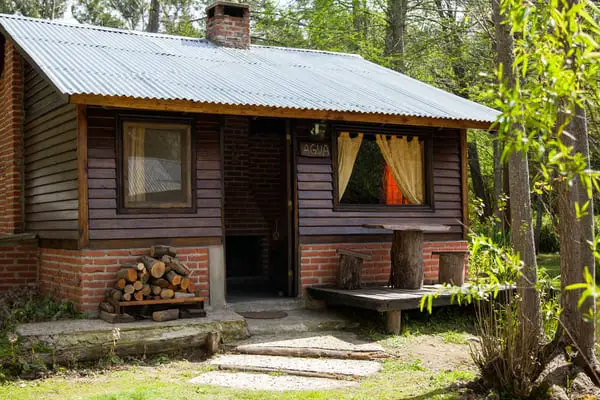
Hut-to-hut mountain biking can be a fun alternative to traditional MTB or Cross-country MTB. It can provide you with the same adventure but with the convenience and comfort of cabin camping. In this section, you’ll be learning what hut-to-hut mountain biking is like in Colorado, as well as a few examples of some hut-to-hut trails, and the advantages of this type of hiking that makes it a hit with hardcore MTB fans.
So, what is hut-to-hut mountain biking? Hut to hut MTB is using strategically placed huts on mountain trails where you can comfortably sleep when you’re doing a strenuous region-to-region MTB ride. These are small lodges that can typically fit 10 to 50 mountain bikers providing a roof, bed, flushable toilet, and a stove. In some cases, they can also be much more minimalist and only provide shelter with no extra amenities.
A great advantage of the hut-to-hut MTB over the long-distance trails is the amount of equipment that you can carry behind your back. With a place to stay and eat, there is no need to carry a tent, sleeping bag, or food and cooking utensils. All the things that you will need are your clothes, rain gear, water, and snacks during the day, and this will free up a lot of stress on your back when riding.
Another great advantage of staying at a hut is that it provides safe emergency shelter for backcountry travelers stranded by poor weather conditions or injuries, which is a big concern in Colorado. You will also have a great hot meal when you decide to do a hut-to-hut ride. No need to worry about cooking on a fire that takes ages to start. Having to stay at a hut gives you a hot and cold shower as well as a toilet that flushes.
The material things are not the only thing that is great about taking advantage of a hut-to-hut mountain bike excursion. You will get to meet a lot of different people and have great conversations with them when staying in a hut. It is also great to hear different adventures from different people when sharing stories of Colorado’s iconic MTB trails.
That’s not all that is great about staying at a hut is that it reduces the potential for human or wildlife conflicts by separating people, food, and wastes from wildlife.
Huts also allow environmental damages to be minimized by controlling human use. Another great thing about the huts is that it prevents fossil fuels by providing more efficient, centralized cooking, water purification, and lighting systems. It lets you enjoy nature without having to go through a lot of processes in making yourself comfortable.
With this in mind, what are some great Hut-to-Hut MTB options in Colorado?
Colorado Trail to Camp Hale
Descend singletrack from Tennessee Pass and the Continental Divide to Camp Hale, the historic WWII training site for the 10th Mountain ski troops. Enjoy moderate trails and roads. Half and Full day options are available at this hut.
Vail Pass to Red Cliff
With the Vail Pass to Red Cliff excursion, you can climb on a graded and gently inclining Forest Service road to the top of Shrine Pass. From there, it’s a gorgeous 8 mile descent through aspen and spruce fir forests and along Turkey Creek to the former mining town of Red Cliff. This one is perfect for half day tours.
Colorado River Road
This full day sightseeing ride is an opportunity to bike through classic Colorado ranch country while following the Colorado River. The road is paved with a short section of well maintained gravel road so choose a road or mountain bike. Guided and self guided tours include a shuttle vehicle. Round trip driving time is approximately one and a half hours from Vail.
Red Sandstone
The Red Sandstone road accesses a variety of roads and single track trails. Lost Lake road, Middle Creek, son o fMiddle Creek, Buffer Creek trails, and the North Trial offer a variety of single track and road options for riders of all abilities.
San Juan Hut To Hut Mountain Biking
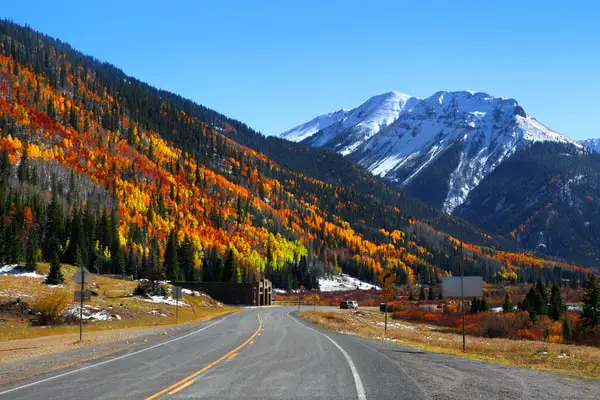
But the main hut-to-hut route (and arguably the most popular) is the multi-day epic from Durango to Moab. Run by San Juan Huts, this seven-day trip can also start in Telluride. Rides are approximately 35 miles each day, with riders each afternoon arriving at a hut equipped with food, water, cooking supplies, and sleeping gear, as well as maps and written route instructions for trails including dirt roads and single track ranging from high alpine to Marlboro Country.
San Juan Huts also offers a shorter five-day trip that also starts in either Durango or Telluride but ends before the final drop into Utah.
Each hut sleeps eight people, and food supplies are replenished regularly. Each hut also has a composting toilet but may have a somewhat limited supply of water. Food ranges widely, with dinners running the gamut from olives and green chilies to quinoa, canned chicken, soups, lentils, and spaghetti, with fresh food including bacon, eggs, cheese, butter, fruits and vegetables, and tortillas.
There are bars, sandwich fixings, and plenty of snacks to keep you going throughout the day.
San Juan Huts maintains a detailed list of the clothing, bike equipment, gear, and clothing you should take on the trips. The huts don’t have electricity to charge electronic items, and there is limited cell service along the way.
Durango to Moab is not the only hut-to-hut bike trip in the region, of course—you’ll find a bevy of remote cabins spread across the mountains. A few options for DIYers include St. Paul Hut on Red Mountain Pass, the Silver Star Hut in La Plata Canyon, and Aladdin’s Lamp Hut on Molas Pass.
Further afield, you can find hut-to-hut bike trips like the three-day gravel and pavement ride from Grand Junction to Moab and the four-day Fruita to Gateway trip.
Breckenridge Mountain Biking
With hundreds of miles of trails, Breckenridge gives riders of all abilities the chance to experience stunning scenery and challenging rides. The top 3 easiest mountain biking trails in Breckenridge are a great place to learn the sport while the top 3 hardest will push you to new challenges.
To get there, start downtown, head North (towards Frisco) and warm up for 1.4 miles on the bike path. The trail starts near a bridge crossing the Blue River, keep an eye open for signs. Either side of the river leads you past Colorado Mountain College. Turn on Coyne Valley Rd to access the other side of the Blue and return towards town.
Being a very busy trail, keep an eye open for fly fishermen, hikers and of course, other cyclists. This trail is probably best ridden as an out and back, starting from the Recycling Center on French Creek (Reiling) Rd. If you’re feeling up to it, you can hit the (steep) climb just above the Recycling Center, or Mike’s Trail on the other end, hooking up with Middle and Upper Flume trails to complete a loop.
Park a car (or ride from town) at the B & B Mines Trailhead on French Creek Rd. and ride up the road for approximately 1.2 miles to turn right for B & B, across the road from Reiling Dredge trailhead parking. Slightly downhill the entire way, with lots of double track and wide singletrack. Pass the historic Reiling Dredge. Amazing views of Breckenridge ski are along the trail.
Additionally, you can option for more difficulty on Turk’s trail, hooking back up with B & B near the end. However you access it, either climbing straight up fire roads in the ski area, or singletrack on Burro Spruce Creek Rd. or trail Wheeler, you’re in for some climbing and pain with this one, which may or may not diminish your MTB performance.
The elevation will hurt you, the weather changing at the drop of a hat will make you miserable. Descending isn’t any easier either. It’s an old hiking trail, all steep, off camber and rutted above treeline. Be prepared for an epic, but start early and reward yourself with a cold beer at the end. Middle Fork to Tiger Dredge Trailhead. Park a car at the Tiger Dredge Trailhead on Tiger Rd. and warm up for a few miles on the road.
Keep an eye open on the left side of Middle Fork of Swan dirt road about two mile past Tiger Run snowmobile tours for signs for CO Trail, and prepare for some of the sweetest singletrack you’ve ridden in the mountains.
Useful Tip: Don’t push too hard though, because the brutal climb starts after you cross the North Fork Rd.
Consider the B-LINE as Well
This one is a fun addition to the “Most Difficult” list. Jumps and bermed turns is what this one’s all about, not elevation change and heart rate. But it will certainly make you think twice about catching air. A great addition to Breck’s set of trails, a skill builder for sure.
Or maybe just one if you are in great physical shape. The B-line starts at the top of Moonstone trail, and ends at Carter park. Depending on the snowpack and weather conditions, some trails may not be accessible until late June. Make sure you check trail conditions before heading out.
Vail Mountain Biking
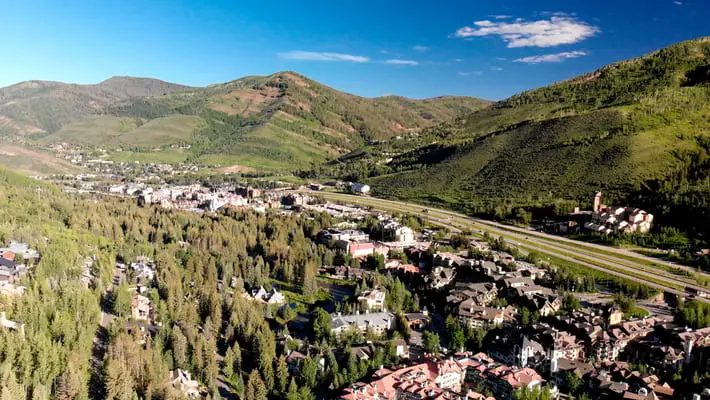
The Vail has distinguished itself as the valley’s original ski resort, the area was also among the first local destinations for mountain bikers, who have pedaled the summer trail network since at least the early 1990s. These days, 26 trails for varying abilities—47.6 miles in all—crisscross the mountain’s frontside and, in a couple of instances, lead to the Back Bowls.
Unlike some resorts that emphasize downhill-specific mountain biking—where riders on sturdy steeds tackle huge jumps and steep wooden ramps and bridges—Vail’s trails are more conducive to cross-country riding. That said, 20 routes allow only descending traffic (designated as “freeride” on the applicable trail map), so you can get into the flow without having to worry about dodging other bikers pedaling up.
Many locals ride up the mountain to access the trail network, but there’s no shame in using the bike haul on Gondola One and the Lionshead Gondola (open daily through Sept 6 then Fri–Sun only through Oct 3), especially if you’re acclimating to the altitude or riding a heavier bike. As of last summer (2020), e-bikes are allowed on Vail Mountain trails, too (but only of the Class 1, pedal-assist variety), which certainly boosts one’s uphill capability.
If you choose to pedal your way up, the preferred route is on Gitalong Road to Post Road, a climb of 6 miles up to Eagle’s Nest; the route affords good views of the mountain’s western flanks.
Vail Trail Terrain: What to Expect
From the top of Gondola One, you can find your sweet spot by descending Sidekick to Golden Gate, two buffed-out, green-rated trails that traverse the front of Vail Mountain for 3 miles through fragrant fir trees, thick stands of aspen that carpet the trails bright yellow in fall, and open meadows. A few rollers and berms along the way let you practice your bike-handling skills.
With its sweeping vistas of the Back Bowls and 14,005-foot-tall Mount of the Holy Cross, the Grand Traverse has long been one of Vail Mountain’s signature trails. In midsummer, the wildflowers—rosy paintbrush, blue-purple larkspur, yellow arnica, and more—really pop. Keep an eye out for grazing sheep, too.
From Eagle’s Nest, the easily navigable route gradually climbs across Game Creek Bowl, then winds around Ptarmigan Ridge and Sun Down Bowl before ending about 4 miles later at the 11,250-foot summit of Vail Mountain, where three ski lifts converge. Ride it out and back, or connect to Mid-Vail Escape to return to the frontside.
Thankfully, the trail now extends to the Two Elk Lodge, with 2 miles of additional singletrack. Radio Flyer is the mountain’s most popular bike trail, and for good reason. Descending 1,257 feet from Eagle’s Nest, almost 2.75 miles of quintessential flow are punctuated by plentiful sculpted rollers—including a 147-yard, giggle-inducing section of 34 rollers that’ll give both your bike’s suspension and your arm-absorption skills a workout.
Toward the end, a few small tabletops serve as a grand finale. Connect to Hank’s Hideaway for another 1.8 miles of meandering trail through towering aspen groves.
Crested Butte Mountain Biking
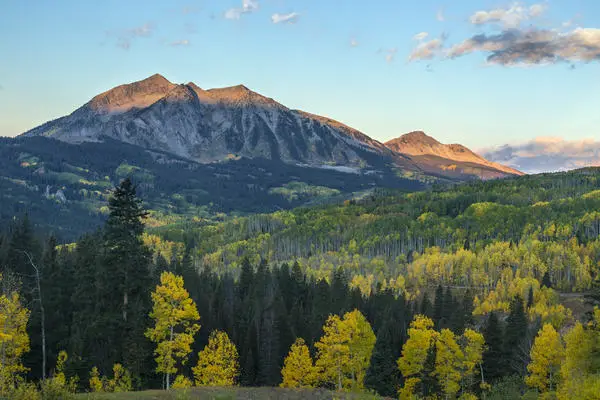
Crested Butte, Colorado is the place where mountain biking was born. Known as one of the premier mountain biking destinations in the United States, there’s truly no parallel for high alpine, mountain bike terrain. From a world-class downhill bike park to stunning singletrack, from high-alpine cross-country routes to trails with breathtaking scenery, there’s truly something for every mountain biker.
But what are the best trails in Crested Butte?
The Lupine Trail is one of the best trails within close proximity to the town of Crested Butte. The hillsides are covered in lupines and other wildflowers in summer, and riders get beautiful views of the surrounding peaks. You’ll also ride through three aspen groves and will have beautiful views of Mt. Crested Butte and the whole valley.
Furthermore, the Lower Loop is a great trail that can be accessed right from town. Riders will find beautiful views of Mt. Crested Butte, Lake Peanut, Paradise Divide, and the Slate River. Wildflower-covered hillsides await riders in summer and golden shaking aspen trees dot the mountains in fall.
This combination of trails covers the whole spectrum of mountain biking terrain. Intermediate to advanced riders will love the long climbs, technical descents, and switchbacks as they make their way through the wilderness. The trails pass through timber forests and open meadows with creek crossings and steep uphills.
The 401 Trail is Crested Butte’s classic mountain biking trail. The approach begins at the ghost town of Gothic, and steep switchbacks and a grueling climb await riders at the trailhead. Once the trail reaches the treeline, the trail narrows to singletrack followed by technical sections. Stunning mountain vistas and knee high wildflowers accompany riders throughout the route.
And finally, for a true challenge, the Dyke Trail feels like a hidden secret as you wind through aspen groves and past Lake Irwin. The trail is marked by fast, flowing singletrack, tough climbs, and a rocky, technical descent. The trailhead begins by Lake Irwin, about a 20-minute drive from the town of Crested Butte.
Fruita Mountain Biking
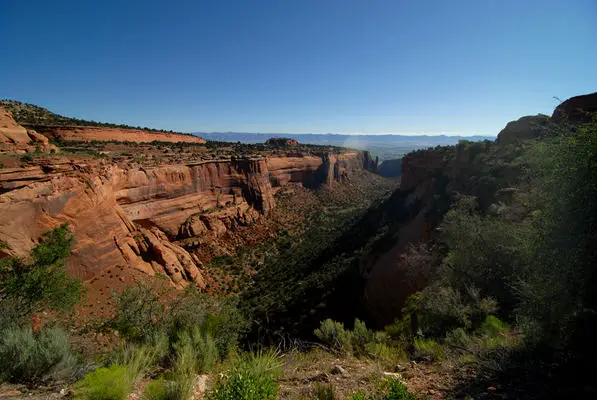
Fruita is now considered by many to be one of the premier mountain biking destinations in Colorado, with the perfect combinations of terrain to challenge riders of all skill levels and abilities. Take a leisurely ride on the 18 Road Trails and just soak up the peaceful Colorado beauty. Or go for it all out—hit the Kokopelli trails, with steep climbs, hair-raising switchbacks, intense downhills, and technical challenges that test the best.
There are so many choices, true believers will most likely want to experience all the trails, each for its own unique value.
The Kokopelli Trail System just west of Fruita offers eight trails also of varying mountain biking skill levels. Rustler’s Loop is a great beginners trail and is about 4 miles. The trail has one good climb in the beginning and then varying terrain throughout. The trail is the first self-teaching mountain biking trail in the United States.
With pullouts at each of the 25 signs along the trail, beginner and experienced riders can learn tips on riding skills, ethics, local geology and plant life.
Mary’s Loop is an intermediate mountain biking trail with some technical challenges but offers truly magnificent views. Mary’s is about 9 miles, but offers cutoffs to Horsethief Bench and Steve’s Trail. Horsethief Bench is an easy intermediate 4-mile ride with a few sections that only advanced bikers ride. Steve’s Trail is also an intermediate trail with moderate degree of physical exertion, but the true distinction of Steve’s is that the rider is literally riding on the cliff’s edge.
The mountain biking trail is about 3 miles. For expert riders, continue on to Moore Fun, a 7-mile trail with switchbacks, hairpin turns, insane rock stair steps and that’s just the beginning. If you’re really feeling adventurous, warm up on Rustler’s Loop, then take Mary’s Loop to Horsethief Bench to Steve’s Trail, then out on the access road to Moore Fun for a perfect 20+-mile mountain bike ride.
The other three mountain biking trails in the system include Troy Built, Mack Ridge and Lion’s Loop, all of which are intermediate-expert trails. Troy Built is 8-miles of some technical sections and breathtaking views. Speaking of breathtaking: the climb at the end of the trail is steep and loose.
Mack Ridge is 7 miles and can be combined with Troy Built for a 15-mile ride. Lion’s Loop, a 7.5-mile trail, is a fun stand-alone trail, but is ideally best at linking Troy Built to Mack Ridge.
Area mountain biking trails offer beautiful views of the Colorado River from the Kokopelli Trails and the Book Cliffs from the 18 Road Trails. Remember that these trails have a variety of terrain that can be tricky. Because Fruita is considered a desert, loose sand/dirt can make turns difficult.
Sharp-edged rocks line many of the trails and switchbacks can be close to rocky ledges. Rocky stair steps can sometimes be loose. Knee and elbow guards can help prevent some injuries from falls or through tight trails. Please stay off muddy trails to avoid resource damage. Seasonal closures may apply as well, so be aware of that.
Ute Valley Park Mountain Biking
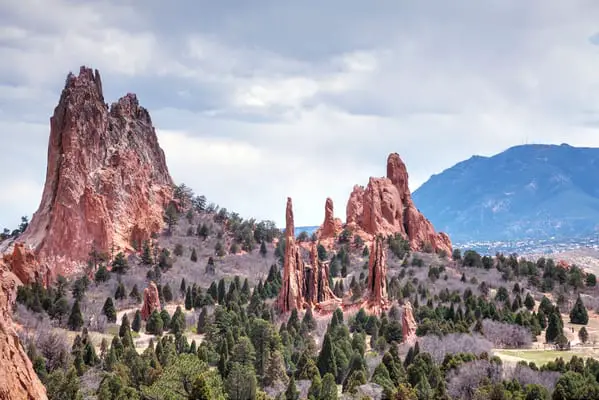
For beginners, and if you’re looking for a scenic cruise, I’d recommend a scenic Ute mountain bike trail in Garden of the Gods. You can also skip the crowds and head to the alternative Red Rock Canyon Open Space. This reclaimed space is home to 15-miles of intermediate trails boasting some nice vantage points of the Morrison Formation, one of the highest concentrations of dinosaur bones in the country.
Red Rock Canyon might not be the most scenic of the Colorado Springs mountain biking trails, but you will find a satisfying singletrack through sandstone hogbacks with this trail.
Here is a selection of Ute Valley Park MTB trails to consider.
Barr Trail
Bagging Pikes Peak is one of those rides worth bragging about. The 26-mile round-trip Barr Trail navigates mountain bikers up to the top of Pikes Peak. If you’re looking for a challenge, then you’ll love Barr Trail, but it’s only for expert riders. You also shuttle to the top for a point-to-point pedal including a mere 129-foot climb to experience a 8,175-foot descent. I recommend the latter, but it’s your journey.
Either way, you will have some of the most inspiring views of the Colorado Springs area.
Starting from the top, you’ll encounter 32 boulder-filled switchbacks called “The Golden Stairs.” You’ll need to be ready to hike-a-bike, as in carry your bike, but for obvious reasons even that isn’t a walk in the park. Once you reach the namesake Barr Camp, you’re about halfway down and onto the easier sections.
Pikes Peak
Pikes Peak Plummet links several fun trails together for a 26-mile ride from the summit back to Colorado Springs. You also get 7,120 feet of descent. Unless you want a really long trip, this route is best serviced by shuttling up Pikes Peak to the Elk Park Trailhead. This is a self-supported trail so prepare to be on remote trails.
It can also be guided if the thought of being at 14,000 feet without cell service is intimidating — and should be taken seriously if you’re new to long-distance, high-alpine treks.
This trail starts technically before reaching the Barr Trail Camp intersection. You’ll find some adrenaline-fueled jumps on the way to Lake Moraine Trail when you reach true isolation. You connect to four other trails to reach the famous Captain Jacks for a truly fun downhill experience. The Chutes is also a super fun section taking you back onto singletrack, high berms and a great flow.
Elk Park
While riding from the summit of Pikes Peak via Barr Trail is an option, getting there and back can be difficult with hikers and trail conditions alike. The Elk Park trail is a solid alternative to Barr and its contingencies. Elk Park doesn’t include Pikes’ 14,115-foot summit, but rather the starting point is a “modest” 11,835.
Depending on how you plan your day, you can utilize existing roads and trails and extend your ride downwards and incorporate the much loved Captain Jacks. Regardless, Elk Creek has plenty of technical challenges on hand, along with creeks, views, gravel and some smooth, smooth dirt.
Palmer Park Loop
This list wouldn’t be complete without a loop in Palmer Park. While you’re here, remember that there are horses, runners, kids and hikers here too, so be mindful of your speed and others. This ride isn’t technical, but it’s here because it showcases the city’s talent of incorporating all kinds of public activities with public land in an urban setting. This is a 12-mile loop that takes in all the park has to offer and it’s worth every pedal.
Telluride Mountain Biking

No matter your skill level, there’s a biking trail for you in Telluride. There are approximately 15 total trails encompassing 17 miles of trails across the ski resort area. There are five miles of green trails, eight miles of blue trails and four miles of black trails.
In addition to everything available in the Telluride Bike Park, the Town of Mountain Village also manages Boomerang, Meadows, Jurassic, Big Billie’s, Boulevard and Russell Trail, all of which are two-way traffic trails. The views from the Telluride Bike Park’s trails are some of the most beloved in the area. Surrounded by 14,000-foot peaks, these trails are some of the most beautiful and unique in the country.
Whether you’re a first-timer or simply want to get more experience mountain biking, Telluride is one of the best all-encompassing networks of MTB trails to consider while in Colorado.
This trail can be a bit tricky to find but is another very fun and meandering downhill that starts near the top of the Sunshine Express Lift. You can start up Prospect trail from the top of the gondola and continue to the top of Lift 10. This trail takes you down in the opposite direction as Prospect, toward Alta Lakes road.
Although you don’t actually get to see the lakes from the trail (unless you traverse hard left off trail) this is still a beautiful ride through wide meadows (including one called “Magic Meadows”) and aspen groves. I highly advise speaking to locals or purchasing a trail map for this one because there are many wrong turn-offs that can lead you astray onto private property.
Additionally, you may want to make sure you have a friend waiting to pick you up at the bottom of Alta Lakes Road, as it is several miles on the highway back to town. The T35 trail is a fast paced “alternative-ending” that takes you from the highway down into Ilium Valley. From the bottom of Alta Lakes Road, take a right and head up the highway about a third of a mile to the trailhead located near a “40mph Speed Limit” sign.
This trail was originally named T35 because the trailhead was under a 35 mph sign, though the sign has since been changed. T35 is a single track that rips through aspen groves and dense forest into Ilium Valley. It is quite steep so beginners should stay off.
So with this in mind, what are the best trails to consider in Telluride?
Jurassic Loop
This is one of the longer, easier trails in the Telluride Area. Start below the Peaks Resort off of Country Club Lane, and continue down through Adam’s Ranch Road to the second trail leg that crosses I-45 into Lawson Hill. 2.2 miles of almost all downhill, you can take the Jurassic Trail at a comfortable pace. This trail provides great views down toward the box canyon end of Telluride, as well as southwest toward Wilson and the Norwood area.
Another great aspect of this trail is the mid-journey stop in Lawson Hill for a lunch break. Aemono and Cindy Bread are both delectable deli’s with fresh food and sandwiches, and the Telluride Brewing Company is also on the hill if you’re looking for a well-deserved cold beer. You can ride back into town along the River Trail, another very pleasant and easy 3-mile trail of ups and downs.
The “Gentleman’s Loop” is a full tour of the mountain, starting on Prospect Trail, then taking Jurassic down to Lawson Hill and finally the River Trail back into town.
See Forever to Wasatch Connection
This is by far the most exciting ride in Telluride with possibly the most brutal uphill in the area. Start at San Sophia Station (the top of the main gondola) and head toward Chair 4 to the start of See-Forever trail. Follow it 2.6 miles past Chair 9 and the Ski Patrol hut to the top of Gold Hill Lift. This scenic point on the trail offers great views of the front side of the ski area, Revelation Bowl and the Bear Creek basin.
The second half of the ride is extremely exposed downhill on narrow trails with dry, loose and sometimes rocky ground. There is a significant amount of no fall area near the beginning of this second section so beware. After several steep switchbacks, the trail opens up on long stretches perfect for letting loose on the breaks and really enjoying your ride.
The trail eventually comes out onto Bear Creek trail and takes you back down into town.
Village Trail
Accessed via the top of the gondola, Village Trail is one of the best on the mountain in terms of reward for time and effort put in. A fairly easy combination of XC and downhill, it has only a few short climbs and mostly mellow downhill. Of course, there are a few spots with loose gravel, but take it slow and you will be A-OK as a beginner.
Despite being relatively easy, this is still one of the most fun trails on the mountain because it is a bit over twice as long as the bike park, significantly more fun to ride through the forest, and deposits you back near the core.
Winter Park Mountain Biking
When warmer weather rolls around, the trails near Winter Park are a prime spot for some of the nation’s best mountain biking, both for cross-country and downhill bikers alike. Winter Park mountain biking makes for a worthy complement to the town’s superb skiing. Aptly dubbed, “Mountain Bike Capital USA,” beginners and veterans alike will find more than enough rides and trail loops in the area to keep them happy when the summer months come around.
So, what are the best trails to consider at Winter Park?
Idlewild
Twisting and turning through 8.7 miles of trails, the Idlewild Trail System is a great combination of challenge and distance, without being overwhelming in either category. Expect to climb more than 1,400 feet while tackling this cross country ride!
Rainmaker
Be sure to visit Trestle Bike Park at Winter Park Resort for a singletrack downhill biking trail that spans 3.3 miles. Rainmaker wears its Black Diamond rating with pride. The technical-minded rider will enjoy taking on the mixture of jumps, wooden obstacles (including the arched Rainbow feature), tabletops and more.
Please note that you have to pay to use this trail, as you need to take the lift up to access it.
Fraser River Bike Trail
If you’re new to mountain biking, or would rather prefer a cruise to a crucible, then the Fraser River Bike Trail is the path for you. A respectable 5.5 miles gives you a tour of the natural beauty that inhabits the Winter Park area.
Keystone Mountain Biking
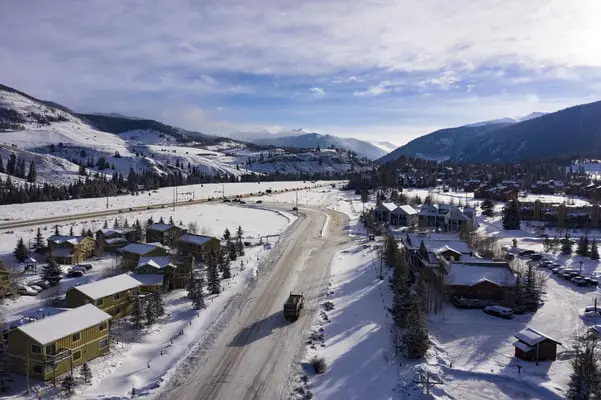
Keystone’s trails maintain a natural feel, mixed with various wooden freeride features and are as buff as the mountain’s rocks and roots allow them to be. While there are rock walls, steep trails, and roots for advanced riders to spend all day figuring out, there are also smooth, fun, and flowy trails for beginners to spend the day conquering.
The Keystone Bike Park usually opens around the middle of June and stays open through most of September. The number of trails available near opening day can be low, but the resort knocks half off the price of lift tickets when pickings are slim, so riders can hit the lower half of the mountain all day While the bikes can handle Keystone’s rocky trails, they see a lot of hands and feet and dirt and rocks and do have some wear and tear.
If you have a hard time adjusting to other bikes or want the comfort of your own, I’d recommend bringing yours along for the trip when riding in Keystone.
With that in mind, Keystone offers some of the rockiest terrain in all of Colorado MTB, which is a welcome feature if you want some of the most challenging jumps and turns worthy of a great cross-country MTB race dynamic.
The Keystone Bike Park is truly a downhiller’s dream. This trail system is professionally-maintained, progression-focused terrain welcomes riders of all abilities, from the base-area skills park to technical rock gardens, drops, and high-speed features.
Keystone’s massive trails system is one of the most progressive downhill and freeride biking areas in the US, but cross-country singletrack is not neglected. Featuring 100 miles of lift-serviced singletrack mountain biking terrain across 34 versatile trails.
